Homepage
•
Learning Library
•
Blog
•
When students become teachers
Expand breadcrumbs
Expand breadcrumbs
- Learning Library
- Blog
- When students become teachers
- Homepage
- •
- Learning Library
- •
- Blog
- •
- When students become teachers








